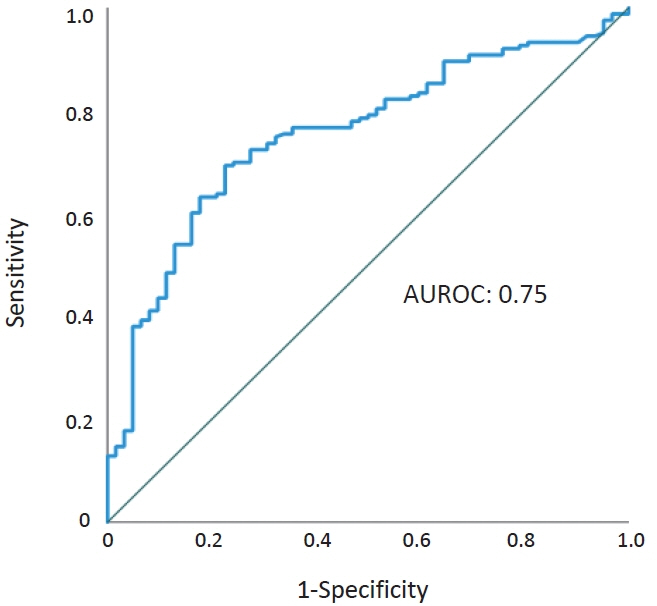Neonatal Med.
2023 Aug;30(3):61-68. 10.5385/nm.2023.30.3.61.
Associations between Maternal sFlt-1/PlGF Ratio and Perinatal and Neonatal Outcomes in Newborns Born to Mothers with Preeclampsia
- Affiliations
-
- 1Department of Pediatrics, Seoul National University Bundang Hospital, Seongnam, Korea
- 2Department of Pediatrics, Kangbuk Samsung Hospital, Sungkyunkwan University School of Medicine, Seoul, Korea
- 3Department of Pediatrics, Dongguk University Ilsan Hospital, Goyang, Korea
- 4Department of Pediatrics, Seoul National University College of Medicine, Seoul, Korea
- KMID: 2545426
- DOI: http://doi.org/10.5385/nm.2023.30.3.61
Abstract
- Purpose
The ratio of soluble fms-like tyrosine kinase 1 (sFlt-1) to placental growth factor (PlGF) is considered a predictive marker of preeclampsia. However, the relationship between the sFlt-1/PlGF ratio and perinatal and neonatal outcomes remains unknown. This study aimed to determine the associations of the sFlt-1/PlGF ratio with perinatal and neonatal outcomes in newborns born to mothers with preeclampsia.
Methods
This retrospective cohort study reviewed singleton neonates born to mothers with preeclampsia who underwent testing for the sFlt-1/PlGF ratio. We investigated the relationship between maternal sFlt-1/PlGF ratios and gestational age (GA), birth weight (Bwt), Bwt z-score, morbidities, and mortality of neonates born to mothers tested for the sFlt-1/PlGF ratio. Maternal sFlt-1/PlGF ratios examined within 30 days before delivery were used for analysis. Neonatal morbidities and mortality were investigated only in preterm infants born earlier than 32 weeks GA.
Results
A total of 225 neonates were included, of which 163 (72.4%) were preterm infants. GA (R=– 0.577, p<0.001), Bwt (R=–0.713, p<0.001), and Bwt z-score (R=–0.608, p<0.001) exhibited significant negative correlations with the sFlt-1/PlGF ratios. Among the 50 preterm infants born earlier than 32 weeks GA, neonatal morbidities were not significantly associated with the sFlt-1/PlGF ratio after adjusting for GA and Bwt.
Conclusion
In mothers with preeclampsia, a higher sFlt-1/PlGF ratio was associated with the delivery of newborns with lower GA and lower Bwt. However, this ratio was not associated with increased morbidity or mortality in premature infants born earlier than 32 weeks GA.
Keyword
Figure
Reference
-
1. Duley L. The global impact of pre-eclampsia and eclampsia. Semin Perinatol. 2009; 33:130–7.2. Roberts JM, Cooper DW. Pathogenesis and genetics of preeclampsia. Lancet. 2001; 357:53–6.3. Levine RJ, Maynard SE, Qian C, Lim KH, England LJ, Yu KF, et al. Circulating angiogenic factors and the risk of preeclampsia. N Engl J Med. 2004; 350:672–83.4. Maynard SE, Min JY, Merchan J, Lim KH, Li J, Mondal S, et al. Excess placental soluble fms-like tyrosine kinase 1 (sFlt1) may contribute to endothelial dysfunction, hypertension, and proteinuria in preeclampsia. J Clin Invest. 2003; 111:649–58.5. Lam C, Lim KH, Karumanchi SA. Circulating angiogenic factors in the pathogenesis and prediction of preeclampsia. Hypertension. 2005; 46:1077–85.6. Chaiworapongsa T, Romero R, Kim YM, Kim GJ, Kim MR, Espinoza J, et al. Plasma soluble vascular endothelial growth factor receptor-1 concentration is elevated prior to the clinical diagnosis of pre-eclampsia. J Matern Fetal Neonatal Med. 2005; 17:3–18.7. Agrawal S, Cerdeira AS, Redman C, Vatish M. Meta-analysis and systematic review to assess the role of soluble FMS-like tyrosine kinase-1 and placenta growth factor ratio in prediction of preeclampsia: the SaPPPhirE study. Hypertension. 2018; 71:306–16.8. Zeisler H, Llurba E, Chantraine F, Vatish M, Staff AC, Sennstrom M, et al. Predictive value of the sFlt-1:PlGF ratio in women with suspected preeclampsia. N Engl J Med. 2016; 374:13–22.9. Lim S, Li W, Kemper J, Nguyen A, Mol BW, Reddy M. Biomarkers and the prediction of adverse outcomes in preeclampsia: a systematic review and meta-analysis. Obstet Gynecol. 2021; 137:72–81.10. Rana S, Powe CE, Salahuddin S, Verlohren S, Perschel FH, Levine RJ, et al. Angiogenic factors and the risk of adverse outcomes in women with suspected preeclampsia. Circulation. 2012; 125:911–9.11. Gestational hypertension and preeclampsia: ACOG Practice Bulletin, Number 222. Obstet Gynecol. 2020; 135:e237–60.12. Papile LA, Burstein J, Burstein R, Koffler H. Incidence and evolution of subependymal and intraventricular hemorrhage: a study of infants with birth weights less than 1,500 gm. J Pediatr. 1978; 92:529–34.13. Kliegman RM, Walsh MC. Neonatal necrotizing enterocolitis: pathogenesis, classification, and spectrum of illness. Curr Probl Pediatr. 1987; 17:213–88.14. Tsatsaris V, Goffin F, Munaut C, Brichant JF, Pignon MR, Noel A, et al. Overexpression of the soluble vascular endothelial growth factor receptor in preeclamptic patients: pathophysiological consequences. J Clin Endocrinol Metab. 2003; 88:5555–63.15. Kuhnel E, Kleff V, Stojanovska V, Kaiser S, Waldschutz R, Herse F, et al. Placental-specific overexpression of sFlt-1 alters trophoblast differentiation and nutrient transporter expression in an IUGR mouse model. J Cell Biochem. 2017; 118:1316–29.16. Witwicki J, Chaberek K, Szymecka-Samaha N, Krysiak A, Pietruski P, Kosinska-Kaczynska K. sFlt-1/PlGF ratio in prediction of short-term neonatal outcome of small for gestational age neonates. Children (Basel). 2021; 8:718.17. Chang YS, Chen CN, Jeng SF, Su YN, Chen CY, Chou HC, et al. The sFlt-1/PlGF ratio as a predictor for poor pregnancy and neonatal outcomes. Pediatr Neonatol. 2017; 58:529–33.18. Verlohren S, Herraiz I, Lapaire O, Schlembach D, Zeisler H, Calda P, et al. New gestational phase-specific cutoff values for the use of the soluble fms-like tyrosine kinase-1/placental growth factor ratio as a diagnostic test for preeclampsia. Hypertension. 2014; 63:346–52.19. Stepan H, Galindo A, Hund M, Schlembach D, Sillman J, Surbek D, et al. Clinical utility of sFlt-1 and PlGF in screening, prediction, diagnosis and monitoring of pre-eclampsia and fetal growth restriction. Ultrasound Obstet Gynecol. 2023; 61:168–80.20. Simon E, Permuy C, Sacristan L, Zamoro-Lorenci MJ, Villalain C, Galindo A, et al. sFlt-1/PlGF ratio for the prediction of delivery within 48 hours and adverse outcomes in expectantly managed early-onset preeclampsia. Pregnancy Hypertens. 2020; 22:17–23.
- Full Text Links
- Actions
-
Cited
- CITED
-
- Close
- Share
- Similar articles
-
- Cord Blood Soluble fms-Like Tyrosine Kinase 1 and Placental Growth Factor in Preterm Infants with Maternal Preeclampsia
- Increased sFlt-1 to PlGF Ratio in Women Who Subsequently Develop Preeclampsia
- A study to compare maternal and perinatal outcome in early vs. late onset preeclampsia
- Maternal Preeclampsia and Bronchopulmonary Dysplasia
- Comparison of perinatal outcomes with gestational weeks and severity of disease in the preterm delivery associated with preeclampsia





